Many years ago while looking to see what new reptiles were in at the local pet shop, I saw my first ball python, Python regius. Needless to say, a few days later I purchased him and brought him home. I named him Kashmire. Thus began my adventures with ball pythons. Now more than twenty years later I still have Kashmire plus over a hundred other different ball pythons. For those who desire to own a python, the ball python is a wonderful choice. They stay small, generally under five feet and normally have a gentle disposition. Kashmire was a sub-adult when he was purchased and I have had him for more than twenty years. Reports of ball pythons living thirty and even forty years have been recorded! Now on to the adventure of buying your first ball python!
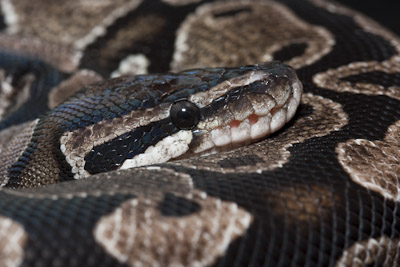 Before you decide to purchase a ball python the first thing you need to do is determine the right kind of cage and equipment needed to
properly house your pet. There are many different types of cages on the market today. Let's look at the size of the cage first. A young
ball python does not need as much space as an adult, a ten gallon terrarium will be able to house a hatchling ball python until it reaches
about 2.5 feet. An adult ball python will be able to live in a twenty to thirty gallon terrarium its' entire life. One of the most
important things to consider when purchasing a cage is - Can it be securely closed? Snakes are escape artists and the ball python is no
exception. If there is any type of opening that they can get through, they will find it and get out! There are many kinds of terrariums
available that have screen tops that slide into place. These tops can be secured by a pin that is placed through the edge of the screen and
the end of the molding on the tank.
Before you decide to purchase a ball python the first thing you need to do is determine the right kind of cage and equipment needed to
properly house your pet. There are many different types of cages on the market today. Let's look at the size of the cage first. A young
ball python does not need as much space as an adult, a ten gallon terrarium will be able to house a hatchling ball python until it reaches
about 2.5 feet. An adult ball python will be able to live in a twenty to thirty gallon terrarium its' entire life. One of the most
important things to consider when purchasing a cage is - Can it be securely closed? Snakes are escape artists and the ball python is no
exception. If there is any type of opening that they can get through, they will find it and get out! There are many kinds of terrariums
available that have screen tops that slide into place. These tops can be secured by a pin that is placed through the edge of the screen and
the end of the molding on the tank.
What kind of substrate do you wish to use? There are many different products out on the market to choose from. Astroturf is commonly included with the terrarium. This can be a good substrate choice. If you choose to use astroturf it would be a good idea to buy a high quality astroturf. This will provide a much longer lasting substrate. Make sure that you get at least two pieces. This way when one becomes soiled it can be easily replaced with a clean piece. Aspen bedding is also a commonly used substrate. It is absorbent and easy to clean. Newsprint is another possibility. Newsprint is the white paper that the newspaper is printed on. It is possible to buy unused portions of newsprint from newspaper printers. This is inexpensive and it is also quick to clean up. Products not to use for bedding include the following: corn cob, alfalfa pellets, sand, gravel and bark. No matter which substrate you choose to use it must be cleaned as soon as you notice that it has become soiled.
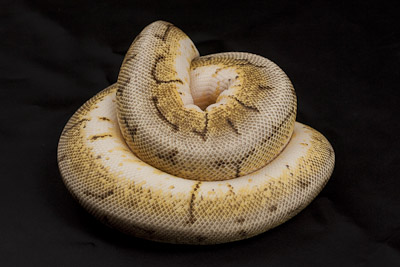 Let us now go through the list of other essential cage furnishings. A hide box is a must for a ball python. There are many different
styles to choose from. Two things to consider are, is it large enough for the snake and is it easy to keep clean. Some hide boxes are made
of wood and others come in the shapes of "rock" caves. They look nice, but are more difficult to clean, since there are so many places for
debris to get stuck in. Water dishes also come in a large variety. They can be as simple as a dog type water dish or as interesting as a
rock basin. If you choose to have more elaborate furnishings, a good scrub brush will be necessary. This will help you to clean out all the
crevices that will be found in the more ornate water dishes and hide boxes. A large branch may be placed in the cage, but is not necessary.
This will provide a surface for the ball python to crawl over and around. It may even provide a good surface to help the snake shed. If you
choose to place anything in the enclosure with your ball python that comes from outside, please make sure that it is completely cleaned,
sterilized and dry before placing it in the cage with your pet. Nothing is worse than having a wonderful set up, a healthy snake and
introducing parasites into your set up from outside.
Let us now go through the list of other essential cage furnishings. A hide box is a must for a ball python. There are many different
styles to choose from. Two things to consider are, is it large enough for the snake and is it easy to keep clean. Some hide boxes are made
of wood and others come in the shapes of "rock" caves. They look nice, but are more difficult to clean, since there are so many places for
debris to get stuck in. Water dishes also come in a large variety. They can be as simple as a dog type water dish or as interesting as a
rock basin. If you choose to have more elaborate furnishings, a good scrub brush will be necessary. This will help you to clean out all the
crevices that will be found in the more ornate water dishes and hide boxes. A large branch may be placed in the cage, but is not necessary.
This will provide a surface for the ball python to crawl over and around. It may even provide a good surface to help the snake shed. If you
choose to place anything in the enclosure with your ball python that comes from outside, please make sure that it is completely cleaned,
sterilized and dry before placing it in the cage with your pet. Nothing is worse than having a wonderful set up, a healthy snake and
introducing parasites into your set up from outside.
The next step is to provide adequate heat and light for your ball python. When considering a possible heat source, please DO NOT buy a hot rock. These can give your ball python severe burns. An under tank heat source is best for your ball python. I personally recommend using a rheostat along with the heater. The amount of heat that is produced can be controlled and adjusted to compensate for temperature fluctuations in your home. In summer it will be necessary, in most climates, to turn down the amount of heat that is produced by the under tank heater and naturally in winter the amount of heat produced will need to be increased. The under tank heater should cover from one-fourth to one third of the bottom of the tank and should be placed at one end of the cage, preferably near the area were the hide box will be. It is important to remember that the air temperature of the cage will not be the same as the temperature of the glass, or wood, directly above the heat source. Check the temperature at this spot. It should not exceed 90? Fahrenheit. It is also a good idea to place a piece of plywood underneath the cage. This will keep the the heating element off of the furniture. Please make sure that you reduce the risk of fire by not overloading outlets. If needed use a power strip. Ball pythons do not require UV lighting. The natural light that comes into your room will be sufficient for your ball python. Do not place the cage in the path of direct sunlight. The temperatures inside the cage can soar and your snake can overheat and die.
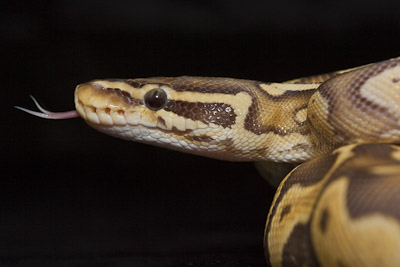 How do I find a healthy snake? Good question. When choosing your ball python look closely at it. Make sure that the skin does not hang
on the animal. The backbone should not stick out. The snake should be round in appearance, not triangular. Check to see if there are any
mites or ticks do not purchase snake that have these external parasites. Snakes with fecal matter around the vent or scabbed over areas on
the body should be avoided. Another common problem is respiratory infections. Wheezing, gurgling and mucus around the nostrils are
indications of a respiratory infection this is also a snake to be avoided. Make sure to disinfect your hands before you look at any other
reptiles in the store if you have handled a sick ball python. If the ball python you are looking at passes your visual inspection, ask to
see its feeding record. If the pet shop can not give you a record, ask for a guarantee that the snake does eat. If they are not willing to
do this for you DO NOT BUY the ball python! If they have other ball pythons to choose from that have feeding records, choose one of them.
Once you bring the ball python home you may wish to have a fecal sample examined by a vet for possible internal parasites. More than one
sample should be taken in at different times often parasites can be missed if only one sample is examined. Naturally buying captive bred is
preferable to buying an imported animal. If at all possible buy a captive bred ball python. The breeder should be able to provide you with
a feeding record. You will want to choose a hatchling that has voluntarily fed at least four times. Most captive bred ball pythons are
available early summer through late fall.
How do I find a healthy snake? Good question. When choosing your ball python look closely at it. Make sure that the skin does not hang
on the animal. The backbone should not stick out. The snake should be round in appearance, not triangular. Check to see if there are any
mites or ticks do not purchase snake that have these external parasites. Snakes with fecal matter around the vent or scabbed over areas on
the body should be avoided. Another common problem is respiratory infections. Wheezing, gurgling and mucus around the nostrils are
indications of a respiratory infection this is also a snake to be avoided. Make sure to disinfect your hands before you look at any other
reptiles in the store if you have handled a sick ball python. If the ball python you are looking at passes your visual inspection, ask to
see its feeding record. If the pet shop can not give you a record, ask for a guarantee that the snake does eat. If they are not willing to
do this for you DO NOT BUY the ball python! If they have other ball pythons to choose from that have feeding records, choose one of them.
Once you bring the ball python home you may wish to have a fecal sample examined by a vet for possible internal parasites. More than one
sample should be taken in at different times often parasites can be missed if only one sample is examined. Naturally buying captive bred is
preferable to buying an imported animal. If at all possible buy a captive bred ball python. The breeder should be able to provide you with
a feeding record. You will want to choose a hatchling that has voluntarily fed at least four times. Most captive bred ball pythons are
available early summer through late fall.
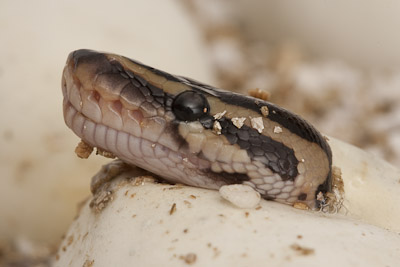 Now that you have brought your new snake home you need to establish a feeding schedule. Hatchling ball pythons will generally feed upon
large fuzzies or hopper mice. Your snake will need to be fed at least once a week. If you wish for your ball python to grow faster feed it
twice a week. Remember that many (twice a week) small meals are better for your growing ball python than one large meal a week. Try to
gradually train your new ball python to accept dead rodents. Use a long pair of hemostats for this. Dangle the thawed and warmed, if you
are using frozen, or freshly killed mouse in front of the snake. Hopefully it will strike at the mouse and eat it. If not, try again later.
Please do not try this using your hand. If your hand is warmer than the mouse there is a very good chance that your hand will be mistaken
for food and you will be bitten. A hatchlings' bite is not too bad, but an adults' bite can be a painful experience. I always encourage
people to train their snakes to eat dead rodents, because often times a live rat or mouse left in a cage can cause severe damage and even
death to a ball python. If your snake refuses to eat dead food, monitor all feedings. If the snake does not eat within five minutes, remove
the food item. If you have purchased an adult or sub-adult ball python, about two feet in length, it will naturally eat larger food items.
A feeding schedule of once a week will be enough to keep your snake healthy. It is important not to over feed your snake. A fat snake is
not a healthy snake. Once again it will be important to train this snake to accept dead food items. Remember to leave your ball python
alone for a couple of days after it has eaten. Handling any snake after it has eaten can cause the snake to regurgitate its meal. To help
you keep track of how often your snake eats it will be necessary to make a record. A standard 3 x 5 card is all that is needed. Record who
the snake came from, when it eats, what it eats, how much it eats, shed dates, weights and any other information you find useful. It is
easy to spot any potential problems if there are unexplained drops in weight or long periods of not feeding. This record will also be
helpful if you ever need to take the snake to the vet. Instead of trying to remember when the snake shed or ate last, you just bring the
card in and show them.
Now that you have brought your new snake home you need to establish a feeding schedule. Hatchling ball pythons will generally feed upon
large fuzzies or hopper mice. Your snake will need to be fed at least once a week. If you wish for your ball python to grow faster feed it
twice a week. Remember that many (twice a week) small meals are better for your growing ball python than one large meal a week. Try to
gradually train your new ball python to accept dead rodents. Use a long pair of hemostats for this. Dangle the thawed and warmed, if you
are using frozen, or freshly killed mouse in front of the snake. Hopefully it will strike at the mouse and eat it. If not, try again later.
Please do not try this using your hand. If your hand is warmer than the mouse there is a very good chance that your hand will be mistaken
for food and you will be bitten. A hatchlings' bite is not too bad, but an adults' bite can be a painful experience. I always encourage
people to train their snakes to eat dead rodents, because often times a live rat or mouse left in a cage can cause severe damage and even
death to a ball python. If your snake refuses to eat dead food, monitor all feedings. If the snake does not eat within five minutes, remove
the food item. If you have purchased an adult or sub-adult ball python, about two feet in length, it will naturally eat larger food items.
A feeding schedule of once a week will be enough to keep your snake healthy. It is important not to over feed your snake. A fat snake is
not a healthy snake. Once again it will be important to train this snake to accept dead food items. Remember to leave your ball python
alone for a couple of days after it has eaten. Handling any snake after it has eaten can cause the snake to regurgitate its meal. To help
you keep track of how often your snake eats it will be necessary to make a record. A standard 3 x 5 card is all that is needed. Record who
the snake came from, when it eats, what it eats, how much it eats, shed dates, weights and any other information you find useful. It is
easy to spot any potential problems if there are unexplained drops in weight or long periods of not feeding. This record will also be
helpful if you ever need to take the snake to the vet. Instead of trying to remember when the snake shed or ate last, you just bring the
card in and show them.
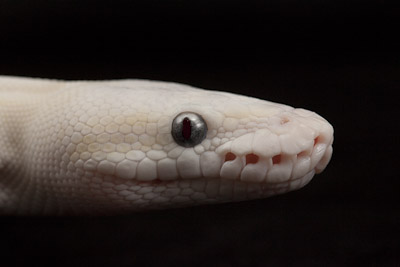 There are some potential problems that you may have with your ball python. The most common is extending periods of not feeding, or
anorexia. If your ball python has been feeding regularly and suddenly stops it could be a number of different things. Is the snake going to
shed? Many snakes will stop eating at this time. Is it winter? During the shorter day lengths and cooler temperatures many ball pythons
will stop feeding. After the shed or after winter the snake will generally begin eating again. If your ball python is an imported animal it
may go off feed in late fall, early winter and not feed again for up to six months. This is not unusual, but it can be very frustrating. If
your ball python was feeding regularly before, just be patient. Chances are that it will begin eating again. If it does not begin feeding
after several months, you will probably need to have the snake force fed. Have an experienced local vet do this. Ball pythons are not easy
to force feed and they may become injured if they are being force fed by someone that does not have any experience force feeding snakes.
Another common problem with ball pythons is dehydration. A common sign of dehydration is a shed that comes off in pieces or wrinkled eyes.
In severe cases the snake appears dull and wrinkled. To help prevent this from happening make sure the temperature in the cage is not too
hot. If an overhead spot light is used for heating the cage it will dry out your ball python. Also make sure your ball python has clean
water at all times. Other common problems are mites and ticks. Mites are small and black. They are commonly found around the eyes of ball
pythons. They can also be found on your hands if you have handled a ball python that is infested with mites. There are numerous products on
the market that can be used to get rid of these pests. Ticks can be removed with forceps. Care must be taken when doing this so that no
mouth parts are left in the snake and that no scales are ripped off of the snake. Apply an antiseptic to the area where the tick was
removed from. This will help to decrease the chance of infection. As mentioned earlier respiratory problems can also occur in ball pythons.
However as long as the ball python you purchased was healthy and proper care has been taken of it, you should not have any health problems.
Burns are avoided by using proper heating equipment. Rodent bites are avoided by training your ball python to feed on dead prey. Mites,
ticks and other parasites are avoided by following proper quarantine procedures and by keeping the cage and furnishings clean.
There are some potential problems that you may have with your ball python. The most common is extending periods of not feeding, or
anorexia. If your ball python has been feeding regularly and suddenly stops it could be a number of different things. Is the snake going to
shed? Many snakes will stop eating at this time. Is it winter? During the shorter day lengths and cooler temperatures many ball pythons
will stop feeding. After the shed or after winter the snake will generally begin eating again. If your ball python is an imported animal it
may go off feed in late fall, early winter and not feed again for up to six months. This is not unusual, but it can be very frustrating. If
your ball python was feeding regularly before, just be patient. Chances are that it will begin eating again. If it does not begin feeding
after several months, you will probably need to have the snake force fed. Have an experienced local vet do this. Ball pythons are not easy
to force feed and they may become injured if they are being force fed by someone that does not have any experience force feeding snakes.
Another common problem with ball pythons is dehydration. A common sign of dehydration is a shed that comes off in pieces or wrinkled eyes.
In severe cases the snake appears dull and wrinkled. To help prevent this from happening make sure the temperature in the cage is not too
hot. If an overhead spot light is used for heating the cage it will dry out your ball python. Also make sure your ball python has clean
water at all times. Other common problems are mites and ticks. Mites are small and black. They are commonly found around the eyes of ball
pythons. They can also be found on your hands if you have handled a ball python that is infested with mites. There are numerous products on
the market that can be used to get rid of these pests. Ticks can be removed with forceps. Care must be taken when doing this so that no
mouth parts are left in the snake and that no scales are ripped off of the snake. Apply an antiseptic to the area where the tick was
removed from. This will help to decrease the chance of infection. As mentioned earlier respiratory problems can also occur in ball pythons.
However as long as the ball python you purchased was healthy and proper care has been taken of it, you should not have any health problems.
Burns are avoided by using proper heating equipment. Rodent bites are avoided by training your ball python to feed on dead prey. Mites,
ticks and other parasites are avoided by following proper quarantine procedures and by keeping the cage and furnishings clean.
Recently there has been a dramatic increase in the number of color morphs available with some species of pythons. The ball python has been no exception. There are many different color variations of the ball python that are now available or that will be available in a few years.
The up and coming years will be full of surprises for those of us that are interested in ball pythons. The possibilities are almost endless for new color variations. For you to have the most rewarding experience possible with your ball python it will be necessary for you to provide it with the appropriate care. No matter which ball python you bring home you will be rewarded with years of enjoyment from one of the most wonderful, in my opinion, python species that is available to us today!
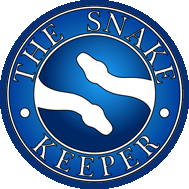


 netviper digital studio
netviper digital studio